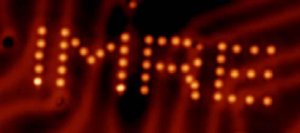Jun 19 2009
Tiny nanobots and machines which heal your body may only exist in science fiction and movie scenes, but for IMRE and CNRS researchers who have been working together on atomic-scale technology, the impact is very real. Their research paves the way for the manipulation of atoms and molecules to build molecule machines and devices.
 3D rendered image of discrete gold atoms arranged to spell out the letters 'IMRE'
3D rendered image of discrete gold atoms arranged to spell out the letters 'IMRE'
The idea might be simple but turning it into reality requires precise manipulation of an individual molecule, a single atom and a metallic cluster in the order of picometers (one-trillionth of a meter) - a feat that only a few in the world have achieved. Led by Prof Christian Joachim from CNRS, the researchers used a Scanning Tunneling Microscope (STM) to build and manipulate atoms and molecules one at a time at a minuscule scale that is practically invisible.
“As the size of devices shrink, there will be a point when devices cannot be built any smaller using conventional fabrication methods”, explains Prof Joachim.
“We have already successfully manipulated atoms into a specified pattern to construct atomic wires, which are one metal atom in width. This marks the first step towards building more complex atomic scale quantum electronics circuits and ultimately molecule-machines”, adds Dr Carlos Manzano, an IMRE research engineer, showing a 3D rendered image of discrete gold atoms arranged to spell out the letters ‘IMRE’ with only 51 atoms.
One of the most important uses for this technology is in computer chips. As it becomes technologically feasible to build structures atom-by-atom, logic gates could be packed neatly into tiny processors the size of a molecule, vastly increasing computing power. Data storage capacity could be multiplied by factors of a million or more in the same way. “With our STM, we have now succeeded in imaging molecular orbitals, which is another important step towards the ability to build molecule-machines” adds Prof Joachim.
Prof Christian Joachim is one of the world’s leading nanotechnology experts. With two Feynman Prizes – an annual award given by the Foresight Nanotech Institute for significant advancement in nanotechnology - to his name, Prof Joachim has been working with a multinational research team from IMRE since 2005 under the A*STAR Visiting Investigator Programme. This programme brings in renowned scientific experts from around the world to Singapore to help seed leading edge R&D programmes.
His link to Singapore dates back to 1980 when he was attached to the French embassy here and taught at the Singapore Polytechnic for a year, as part of his French National Service. It was during this time that he started work on molecular electronics, a little known field of research that holds the key to reducing the size of electronics to the atomic scale.
Prof Joachim is proud to present his new book entitled, “Nanoscience: The Invisible Revolution”, where he provides a scientific and historical perspective on nanosciences and molecule machines. The official launch of the book is 10 June 2009.